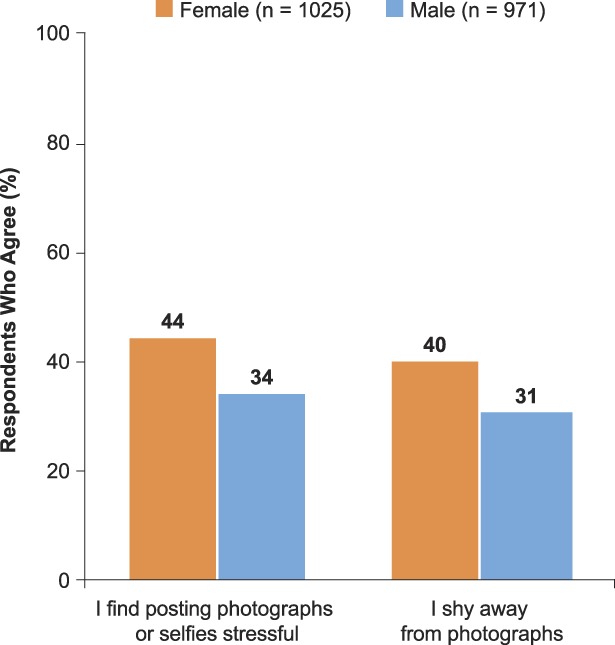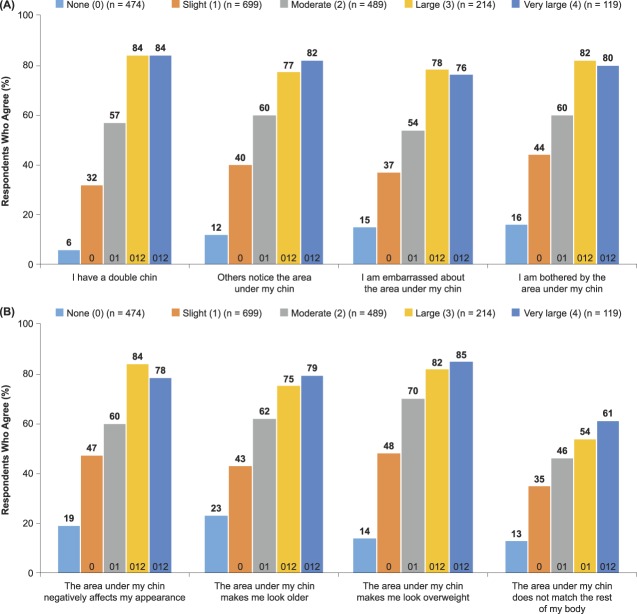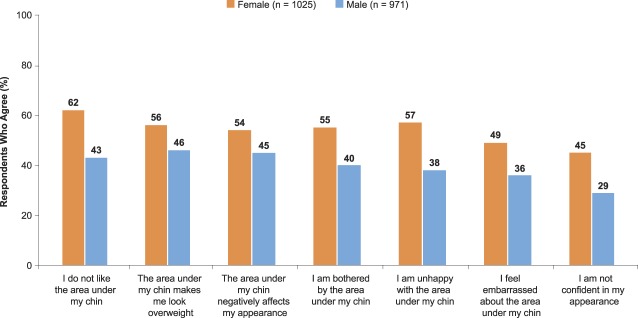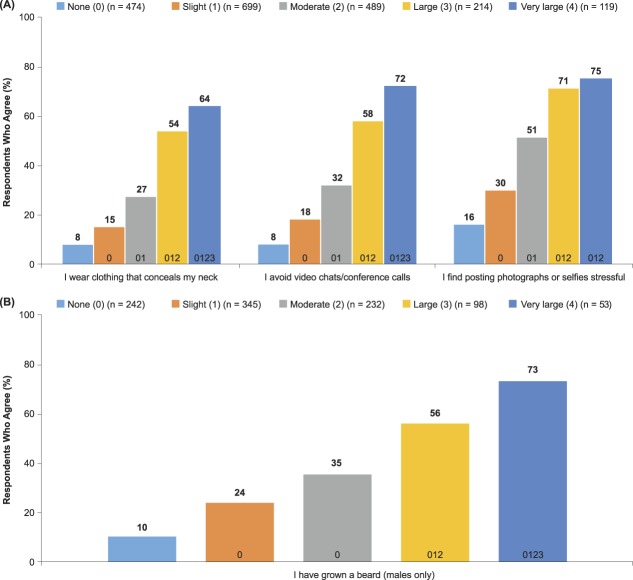Supplemental Digital Content is Available in the Text.
Abstract
BACKGROUND
Satisfaction with discrete facial areas influences self-perceptions of attractiveness, self-esteem, and quality of life. Currently, there is a lack of understanding of how the submental area impacts feelings and behaviors.
OBJECTIVE
To characterize the effects of submental fat (SMF) on feelings/emotions and actions/behavior among adults in the United States.
METHODS
Online health-based surveys recruited approximately 400 adults (18–65 years) in each of 5 categories based on the respondent's assessment of their SMF. Respondents either agreed or disagreed with 17 statements regarding their feelings/emotions and actions/behaviors related to the area underneath their chin.
RESULTS
Overall, 1996 respondents were included (equal distribution of males/females; mean age, 41.9 years). Even a slight amount of chin fat was associated with negative feelings and behaviors. As SMF increased, so did the number of respondents reporting negative self-perceptions such as being embarrassed by the area under their chin. In general, a greater percentage of female compared with male respondents reported negative feelings and behavioral changes due to their submental area.
CONCLUSION
Excess SMF can have a substantial negative effect on a person's feelings of attractiveness and behaviors. Reduction of SMF may not only improve one's appearance, but also may enhance one's self-esteem.
Satisfaction with one's appearance and associated feelings of attractiveness contribute to high self-esteem, which increases happiness, enjoyment of life, and even employment gratification.1 Facial features are the greatest contributor to perceptions of attractiveness,2–5 and trait judgments by others based on facial appearance occur instantaneously.6 Satisfaction with discrete facial areas can affect overall satisfaction with the face and one's self-esteem.7–13 Features such as skin blemishes, wrinkles, unwanted hair, nasal shape, cheek projection, and one's smile can have profound effects on a person's feelings about their appearance. One common area of facial aesthetic concern is the chin and jawline (submental area).14 Accumulation of submental fat (SMF), which contributes to loss of submental definition, can result from genetics15 or lifestyle factors, and can be resistant to reduction through diet and exercise.16 According to the 2017 American Society for Dermatologic Surgery consumer survey, 73% of 7,322 respondents were bothered by excess fat under the chin/neck.17 Furthermore, data from randomized controlled clinical trials with validated end points have indicated that SMF can negatively affect the psychological well-being of an individual.18–21
Currently, there is a lack of understanding of the breadth of impact of SMF on self-perceptions of attractiveness and how the aesthetics of the area under the chin affects behavior. Analyses of the effects of the submental area are underrepresented in cosmetic medicine largely because of lack of research and until recently, lack of available treatment options for submental contouring. To fill this knowledge gap, the current study was conducted to characterize the impact of SMF on emotional well-being and social behavior among adults in the United States.
Methods
Study Design
Respondents were recruited from the Harris Poll Online Panel, an online market research panel of representative samples of the general population or other third-party online panels used by Harris in the United States consisting of individuals who volunteered to complete health-related surveys. Survey volunteers were recruited through offers on partner websites, targeted emails sent by online partners, graphical and text banner placement on partner websites, trade show presentations, targeted postal mail invitations, and targeted telephone calls. Residents of the United States who were 18 to 65 years of age were eligible to complete the secure online questionnaire. Respondents rated their SMF using the validated 5-point descriptive Patient-Reported SMF Rating Scale (PR-SMFRS) used in the phase 3 ATX-101 (deoxycholic acid injection) clinical trials.18–21 The goal was to recruit 400 respondents for each of the 5 PR-SMFRS grades (no chin fat [Grade 0], slight amount of chin fat [1], moderate amount of chin fat [2], large amount of chin fat [3], and very large amount of chin fat [4]) for a total of 2,000 respondents.
For this analysis, respondents indicated their attitudes toward their SMF by answering strongly disagree, somewhat disagree, somewhat agree, or strongly agree to 17 statements that assessed their feelings/emotional well-being and actions/behaviors related to the area underneath their chin (see Supplemental Digital Content 1, Table, listing the 17 statements, http://links.lww.com/DSS/A107). Eleven statements assessed feelings/emotional well-being, whereas 6 assessed actions/behaviors.
Statistical Analysis
For the current analyses, responses to the statements were dichotomized into either disagree or agree. Data were weighted to reflect a nationally representative sample of adults from the United States. Base sizes shown throughout the manuscript are weighted base sizes. All statistical comparisons were made using t-tests for mean values and proportions.
Results
Demographic Characteristics of Respondents
In total, 1996 respondents were included in this study (no chin fat [n = 400], slight amount of chin fat [n = 400], moderate amount of chin fat [n = 400], large amount of chin fat [n = 400], and very large amount of chin fat [n = 396]) (see Supplemental Digital Content 2, Table, reporting weighted demographic characteristics of all respondents, http://links.lww.com/DSS/A108; and Supplemental Digital Content 3, Table, reporting weighted demographic characteristics of respondents by SMF severity, http://links.lww.com/DSS/A109). There was an equal distribution of male and female respondents. Mean age was 41.9 years.
Impact of Submental Fat on Feelings/Emotional Well-Being
Analysis by Submental Fat Severity
For 8 of the 11 statements, the percentage of respondents who felt negatively about the area under their chin increased significantly as SMF increased, with a plateau occurring for those with large or very large amounts of chin fat (Figure 1). For most statements, a moderate amount of chin fat was the point at which greater than 50% of respondents reported negative feelings. Surprisingly, more than one-third of respondents with only a slight amount of chin fat reported negative feelings associated with the submental area, indicating that even a small amount of SMF can impact one's self-perceptions.
Figure 1.
Impact of submental fat (SMF) on feelings/emotional well-being based on SMF severity. (A) The proportion of respondents who felt that they have a double chin, that others notice the area underneath their chin, and that they are embarrassed and bothered by this area increased among respondents with greater amounts of SMF. (B) The proportion of respondents who felt that the area underneath their chin negatively affects their appearance, makes them look older, makes them look overweight, and does not match the rest of their body also increased among respondents with greater amounts of SMF. Numbers at the base of each column denote SMF grades with significant differences (p < .05).
Analysis by Sex
For most statements, significantly more female than male respondents indicated that the area underneath the chin had a negative impact on their feelings/emotional well-being (Figure 2). This was despite the fact that there was no significant difference in the percentage of female versus male respondents noting that they have a double chin. This reveals that although the same percentage of males and females feel that they have a double chin, more females are negatively affected by this area. Additional results on the impact of SMF on feelings/emotional well-being are provided in Supplemental Digital Content 1 (Table, http://links.lww.com/DSS/A107).
Figure 2.
Impact of submental fat (SMF) on feelings/emotional well-being based on the sex of the respondent. Across all grades of SMF, a greater proportion of female relative to male respondents had negative self-perceptions associated with the area underneath the chin. p < .05 for all comparisons between female and male respondents.
Impact of Submental Fat on Actions/Behaviors
Analysis by Submental Fat Severity
The proportion of respondents reporting behavioral changes because of their SMF ranged from 8% in those with no chin fat to 75% in those with a very large amount of chin fat (Figure 3). The behaviors most impacted by the presence of SMF were wearing clothing to conceal the neck, growing a beard (males only), avoiding video chats/conference calls, and finding posting photographs/selfies on social media stressful. In all 4 of these categories, as SMF increased, there was a significant and proportional increase in respondents engaging in or avoiding these behaviors. Interestingly, unlike the observations related to feelings about the submental area, there was a significant increase between the large and very large amount of chin fat groups in the number of respondents wearing clothing or growing a beard to conceal the neck and avoiding video chats/conference calls. This indicates that although a similar number of people report negative feelings about the area under their chin in these 2 groups, significantly more respondents in the very large amount of chin fat group engage in specific behaviors due to this area.
Figure 3.
Impact of submental fat (SMF) on actions/behaviors based on SMF grade. (A) Respondents with greater amounts of SMF were more likely to wear clothing to conceal their neck area, avoid video chats/conference calls, and find posting photographs/selfies stressful owing to the area underneath their chin. (B) For males only, respondents with greater amounts of SMF were more likely to grow a beard. Numbers at the base of each column denote SMF grades with significant differences (p < .05).
Analysis by Sex
Male and female respondents showed a significant difference in their comfort with being photographed and posting photographs/selfies on social media (Figure 4). More female versus male respondents stated that they shy away from photographs (40% vs 31%) and tend to find posting photographs/selfies on social media stressful (44% vs 34%) because of the appearance of the area underneath their chin, suggesting that females are perhaps more critical of their appearance in photographs if they feel that the area below their chin looks unattractive. Additional results on the impact of SMF on actions/behaviors are provided in Supplemental Digital Content 1 (Table, http://links.lww.com/DSS/A107).
Figure 4.

Impact of submental fat (SMF) on actions/behaviors based on the sex of the respondent. Across all grades of SMF, female respondents were more likely than male respondents to find posting photographs/selfies stressful and to shy away from photographs due to the area underneath the chin. p < .05 for both comparisons between female and male respondents.
Discussion
Results from this study provide evidence of the substantial impact of SMF not only on an individual's emotional well-being but also on their behaviors. Feelings of looking older or overweight and being bothered or embarrassed by the submental area potentially affect one's self-esteem and may be motivating factors for seeking treatment to reduce SMF. Overall, these data offer health care providers a better understanding of the effects of SMF on psychological well-being and behavior, information currently lacking in peer-reviewed literature.
Our existing knowledge of the psychological impact of SMF largely stems from clinical trials that focused on adults with moderate or large amounts of SMF.18–21 This study included adults with all grades of SMF, thus expanding our understanding of the impact of SMF on well-being.
Although significantly more respondents with a moderate or greater amount of SMF reported a negative impact of their SMF, it is worth noting trends that were revealed for those with only a slight amount of chin fat. For example, more than one-third of respondents with only a slight amount of chin fat compared with those who had no chin fat reported significant negative feelings due to this area. These data reveal for the first time that even a small amount of SMF can have a negative psychological impact and that this impact does not necessarily correlate with SMF severity. Patient concerns about SMF must be taken seriously regardless of the degree of fat present. Physicians should be aware of this and discuss the submental area when consulting with all patients concerned about facial appearance. Excess SMF could be contributing to a patient's overall dissatisfaction with their appearance, even if the amount of SMF is small and the patient does not focus on this area during an initial consultation. Patients may not be aware of how this area may be affecting their behaviors or self-perceptions.
Another interesting trend revealed in the current study is that a similar percentage of respondents with a large and very large amount of chin fat reported negative feelings associated with this area, indicating that there may be a plateau that occurs at the “large” SMF grade. This observation suggests that a reduction of a single SMF grade in patients with a very large amount of chin fat may not produce psychologically satisfactory results.
In general, females in Westernized cultures have more body dissatisfaction than males.7 The current data indicate that more females than males are negatively affected by excess SMF. Even when there were no statistically significant differences between female and male respondents, a higher proportion of females almost always reported negative feelings or changes in behavior due to the area underneath their chin. Respondents in the current study reported an approximately 2-fold increase in wearing clothing that conceals the neck with each increasing grade of SMF (0–3). This reflects data showing that (in females) increased body mass index and body dissatisfaction are associated with the use of clothing for the purpose of camouflage.22–24
A limitation of this study is the lack of control for psychiatric confounding factors such as having a diagnosis of body dysmorphic disorder (BDD) or eating disorder. Individuals with these diagnoses display extreme body dissatisfaction7 and, therefore, the inclusion of this population has the potential to skew the results. However, BDD affects only 1% to 2% of the population in the United States,7 so individuals with BDD responding to this survey are unlikely to influence the overall findings. Another potential limitation is that respondents were those volunteering to complete health-based online surveys, thus excluding populations with limited internet access or those less likely to respond to health-based questionnaires. Other limitations include a lack of interviewer/physician presence to independently assess the SMF of the respondents and that respondents were from the United States; therefore, these findings may not necessarily apply to individuals from other countries/societies.
The data from the current study help to characterize the impact of the submental area on feelings and behaviors as well as potential drivers for individuals seeking aesthetic treatments to improve their submental contour. The level of satisfaction or dissatisfaction a person has with their appearance influences the likelihood that they will seek out ways to change their physical characteristics.7 It is important for physicians to be aware of the possible broader effects of SMF and how treatment might not only improve physical appearance but also the psychological well-being of patients. Physicians should proactively evaluate the submental area during aesthetic consultations and inquire if patients are bothered by this area in order to educate them on available treatment options.
Footnotes
Supplemental digital content is available for this article. Direct URL citations appear in the printed text and are provided in the HTML and PDF versions of this article on the journal's Web site (www.dermatologicsurgery.org).
This study was sponsored by Allergan plc, Dublin, Ireland. Writing and editorial assistance was provided to the authors by Evidence Scientific Solutions, Inc., Philadelphia, Pennsylvania, and funded by Allergan plc, Dublin, Ireland. All authors met the ICMJE authorship criteria. Neither honoraria nor payments were made for authorship.
L. Baumann has previously received grants from Allergan and currently receives payment for lectures including service on speakers' bureaus from Allergan. S.M. Shridharani is an advisory board member and consultant for Allergan, Galderma, Merz, and Miramar Labs. S. Humphrey currently receives payment for lectures including service on speakers' bureaus from Allergan and serves as a consultant and/or investigator for Allergan, Galderma, Merz, Revance, Evolus, and BonTi. C.J. Gallagher is an employee of Allergan plc.
References
- 1.Patzer GL. Self-esteem and physical attractiveness. J Esthet Dent 1995;7:274–7. [DOI] [PubMed] [Google Scholar]
- 2.Alley TR, Hildebrandt KA. Determinants and consequences of facial aesthetics. In: Alley TR, editor. Social and Applied Aspects of Perceiving Faces. Hillsdale, NJ: Lawrence Erlbaum Associates, Inc.; 1988; pp. 101–40. [Google Scholar]
- 3.Ehlinger-Martin A, Cohen-Letessier A, Taieb M, Azoulay E, et al. Women's attitudes to beauty, aging, and the place of cosmetic procedures: insights from the QUEST Observatory. J Cosmet Dermatol 2016;15:89–94. [DOI] [PubMed] [Google Scholar]
- 4.Honigman R, Castle DJ. Aging and cosmetic enhancement. Clin Interv Aging 2006;1:115–9. [DOI] [PMC free article] [PubMed] [Google Scholar]
- 5.Patzer GL. Understanding the causal relationship between physical attractiveness and self-esteem. J Esthet Dent 1996;8:144–7. [DOI] [PubMed] [Google Scholar]
- 6.Saegusa C, Watanabe K. Judgments of facial attractiveness as a combination of facial parts information over time: social and aesthetic factors. J Exp Psychol Hum Percept Perform 2016;42:173–9. [DOI] [PubMed] [Google Scholar]
- 7.Sarwer DB, Polonsky HM. Body image and body contouring procedures. Aesthet Surg J 2016;36:1039–47. [DOI] [PubMed] [Google Scholar]
- 8.Finn CJ, Cox SE, Earl ML. Social implications of hyperfunctional facial lines. Dermatol Surg 2003;29:450–5. [DOI] [PubMed] [Google Scholar]
- 9.Berscheid E, Walster E, Bohrnstedt G. The happy American body: a survey report. Psychol Today 1973;7:119–31. [Google Scholar]
- 10.Van der Geld P, Oosterveld P, Van Heck G, Kuijpers-Jagtman AM. Smile attractiveness. Self-perception and influence on personality. Angle Orthod 2007;77:759–65. [DOI] [PubMed] [Google Scholar]
- 11.Orion E, Wolf R. Psychologic consequences of facial dermatoses. Clin Dermatol 2014;32:767–71. [DOI] [PubMed] [Google Scholar]
- 12.Lipton MG, Sherr L, Elford J, Rustin MH, et al. Women living with facial hair: the psychological and behavioral burden. J Psychosom Res 2006;61:161–8. [DOI] [PubMed] [Google Scholar]
- 13.Springer IN, Schulze M, Wiltfang J, Niederberger U, et al. Facial self-perception, well-being, and aesthetic surgery. Ann Plast Surg 2012;69:503–9. [DOI] [PubMed] [Google Scholar]
- 14.Jagdeo J, Keaney T, Narurkar V, Kolodziejczyk J, et al. Facial treatment preferences among aesthetically oriented men. Dermatol Surg 2016;42:1155–63. [DOI] [PubMed] [Google Scholar]
- 15.Raveendran SS, Anthony DJ, Ion L. An anatomic basis for volumetric evaluation of the neck. Aesthet Surg J 2012;32:685–91. [DOI] [PubMed] [Google Scholar]
- 16.Thomas WW, Bloom JD. Neck contouring and treatment of submental adiposity. J Drugs Dermatol 2017;16:54–7. [PubMed] [Google Scholar]
- 17.American Society for Dermatologic Surgery. 2017 consumer survey on cosmetic dermatologic procedures. Available at: https://www.asds.net/2017-consumer-survey/. Accessed June 30, 2017.
- 18.Ascher B, Hoffmann K, Walker P, Lippert S, et al. Efficacy, patient-reported outcomes and safety profile of ATX-101 (deoxycholic acid), an injectable drug for the reduction of unwanted submental fat: results from a phase III, randomized, placebo-controlled study. J Eur Acad Dermatol Venereol 2014;28:1707–15. [DOI] [PMC free article] [PubMed] [Google Scholar]
- 19.Humphrey S, Sykes J, Kantor J, Bertucci V, et al. ATX-101 for reduction of submental fat: a phase III randomized controlled trial. J Am Acad Dermatol 2016;75:788–97. [DOI] [PubMed] [Google Scholar]
- 20.Jones DH, Carruthers J, Joseph JH, Callender VD, et al. REFINE-1, a multicenter, randomized, double-blind, placebo-controlled, phase 3 trial with ATX-101, an injectable drug for submental fat reduction. Dermatol Surg 2016;42:38–49. [DOI] [PubMed] [Google Scholar]
- 21.Rzany B, Griffiths T, Walker P, Lippert S, et al. Reduction of unwanted submental fat with ATX-101 (deoxycholic acid), an adipocytolytic injectable treatment: results from a phase III, randomized, placebo-controlled study. Br J Dermatol 2014;170:445–53. [DOI] [PMC free article] [PubMed] [Google Scholar]
- 22.Tiggemann M, Andrew R. Clothing choices, weight, and trait self-objectification. Body Image 2012;9:409–12. [DOI] [PubMed] [Google Scholar]
- 23.Tiggemann M, Lacey C. Shopping for clothes: body satisfaction, appearance investment, and functions of clothing among female shoppers. Body Image 2009;6:285–91. [DOI] [PubMed] [Google Scholar]
- 24.Trautmann J, Worthy SL, Lokken KL. Body dissatisfaction, bulimic symptoms, and clothing practices among college women. J Psychol 2007;141:485–98. [DOI] [PubMed] [Google Scholar]





